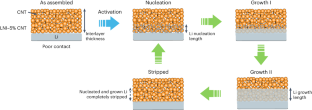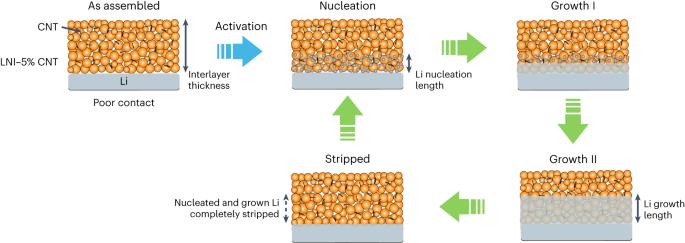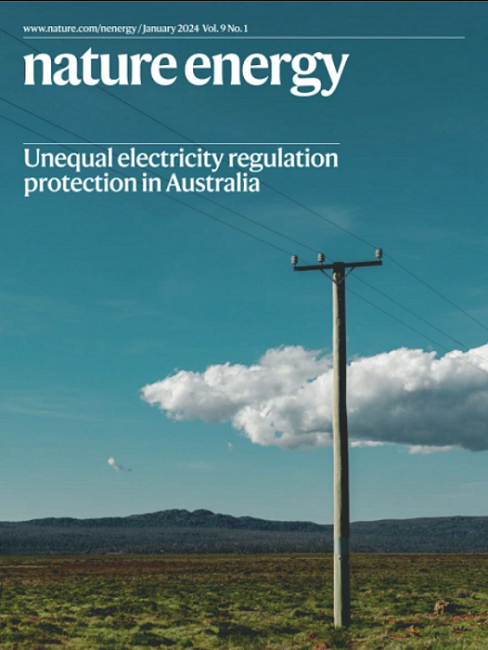Lithium anode interlayer design for all-solid-state lithium-metal batteries
IF 60.1
1区 材料科学
Q1 ENERGY & FUELS
引用次数: 0
Abstract
All-solid-state lithium-metal batteries (ASSLBs) have attracted intense interest due to their high energy density and high safety. However, Li dendrite growth and high interface resistance remain challenging due to insufficient understanding of the mechanism. Here we develop two types of porous lithiophobic interlayer (Li7N2I–carbon nanotube and Li7N2I–Mg) to enable Li to plate at the Li/interlayer interface and reversibly penetrate into the porous interlayer. The experimental and simulation results reveal that a balance of lithiophobicity, electronic and ionic conductivities and interlayer’s porosity are the key enablers for stable Li plating/stripping at a high capacity. A fine-tuned Li7N2I–carbon nanotube interlayer enables Li/LNI/Li symmetric cell to achieve a high critical current density of 4.0 mA cm−2 at 4.0 mAh cm−2 at 25 °C; the Li7N2I–Mg interlayer enables a Li4SiO4@LiNi0.8Mn0.1Co0.1O2/Li6PS5Cl/20 µm-Li full cell to achieve an areal capacity of 2.2 mAh cm−2, maintaining 82.4% capacity retention after 350 cycles at 60 °C at a rate of 0.5 C. The interlayer design principle opens opportunities to develop safe and high energy ASSLBs. All-solid-state lithium-metal batteries are at the forefront of battery research and development. Here C. Wang and colleagues have developed an interlayer design strategy to address issues associated with lithium dendrite growth and interface resistance, resulting in substantial improvements in battery performance.


全固态锂金属电池的锂阳极夹层设计
全固态锂金属电池(ASSLBs)因其高能量密度和高安全性而备受关注。然而,由于对其机理了解不足,锂枝晶的生长和高界面电阻仍然是一项挑战。在此,我们开发了两种多孔疏锂中间膜(Li7N2I-碳纳米管和 Li7N2I-Mg),使锂离子能够在锂/中间膜界面上板结,并可逆地渗透到多孔中间膜中。实验和模拟结果表明,疏锂性、电子和离子电导率以及层间孔隙率之间的平衡是实现稳定的高容量锂镀层/剥离的关键因素。经过微调的 Li7N2I 碳纳米管中间膜使锂/LNI/锂对称电池在 25 °C 下达到 4.0 mAh cm-2 的高临界电流密度;Li7N2I-Mg 中间膜使 Li4SiO4@LiNi0.8Mn0.1Co0.1O2/Li6PS5Cl/20 µm 锂全电池达到 2.2 mAh cm-2 的面积容量,在 60 °C 下以 0.5 C 的速率循环 350 次后保持 82.4% 的容量保持率。层间设计原理为开发安全、高能的 ASSLB 带来了机遇。
本文章由计算机程序翻译,如有差异,请以英文原文为准。
求助全文
约1分钟内获得全文
求助全文
来源期刊

Nature Energy
Energy-Energy Engineering and Power Technology
CiteScore
75.10
自引率
1.10%
发文量
193
期刊介绍:
Nature Energy is a monthly, online-only journal committed to showcasing the most impactful research on energy, covering everything from its generation and distribution to the societal implications of energy technologies and policies.
With a focus on exploring all facets of the ongoing energy discourse, Nature Energy delves into topics such as energy generation, storage, distribution, management, and the societal impacts of energy technologies and policies. Emphasizing studies that push the boundaries of knowledge and contribute to the development of next-generation solutions, the journal serves as a platform for the exchange of ideas among stakeholders at the forefront of the energy sector.
Maintaining the hallmark standards of the Nature brand, Nature Energy boasts a dedicated team of professional editors, a rigorous peer-review process, meticulous copy-editing and production, rapid publication times, and editorial independence.
In addition to original research articles, Nature Energy also publishes a range of content types, including Comments, Perspectives, Reviews, News & Views, Features, and Correspondence, covering a diverse array of disciplines relevant to the field of energy.
 求助内容:
求助内容: 应助结果提醒方式:
应助结果提醒方式:


